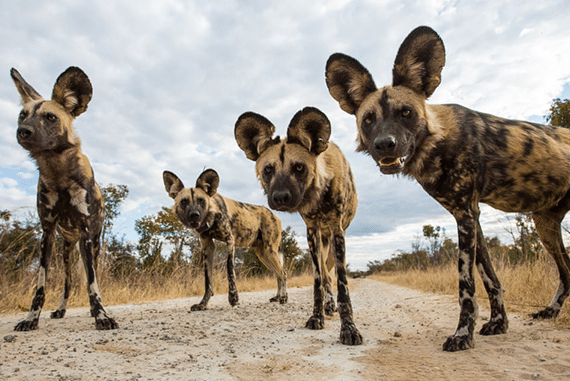
The African wild dog, also known as the Cape hunting dog or painted dog, is a unique and beautiful species. Defined by their rounded ears, white tipped tails and mottled coats as well as their patterned coats with patches of red, black, brown, white and yellow fur they are a magnificent sight to behold. Each animal is distinct by design, with a completely unique coat pattern and unlike other dogs, these long-legged canines have four toes, not five.
“The African Wild dog is the second most endangered mammal in Africa. Their numbers are thought to be less than 5 000, with as few as 300 in the Kruger National Park.”
A threatened existence
The African wild dog is the second most endangered mammal in Africa. Their numbers are thought to be less than 5 000, with as few as 300 in the Kruger National Park.
Sadly, wild dog populations have dwindled dramatically in recent years. Today, there are significantly reduced populations, found in small numbers across Botswana, Zimbabwe, Namibia, Tanzania, Mozambique and of course South Africa, where the largest remaining population can be found in the Greater Kruger National Park.
Hunting in packs of six to 20, these dogs are lethal predators. Feeding predominantly on antelopes – but also larger prey, such as zebra and wildebeest, wild dogs are known to cover massive distances in one day frequently crossing over the boundaries of The Greater Kruger and into neighbouring farmlands.
Impact most on their existence, wild dogs roaming areas are becoming more confined due to human encroachment with the threat of diseases like rabies and canine distemper on the rise. Further to this, outside of conservancies African wild dogs have developed a liking for livestock, a trait has positioned them as a threat to farmers needing to protect their livestock.
A social pack
African wild dogs live in packs and are led by a monogamous breeding pair. They are highly social and cooperative animals with litters ranging in size from two to 20.
Hunting and parental responsibilities are shared by the entire pack and even the weakest play a role. The dogs communicate by touch actions and vocalisation. After a hunt, the pack brings food back to the pups and the babysitter by regurgitating the morning or evening’s meal.
10 facts about wild dogs
1: Each wild dog’s coat is unique in colouring.
2: Wild dogs live in tightly knit social groups of between six and 50 individuals.
3: Pups come first in the pack. Then, the old or injured. Adult pack members patiently wait on the side lines, standing guard until it is their turn to feed. Due to this ranking system, they almost never fight amongst themselves over food.
4: Wild dogs feed their young by regurgitating the food into the puppy’s mouths.
5: Wild dogs cannot be domesticated.
6: Wild dogs can reach speeds of up to 70km/h.
7: A wild dog can eat up to 2 – 4kgs of meat a day.
8: The alpha female is the core of the pack – leading her pack from its formation until she dies. Once she dies the pack splits up and goes their own ways.
9: Wild dogs have a life span of around 10 years.
10: Lions, hyenas and humans are their greatest threat.
We need to keep our mammals “In Safe Hands” not only for future generations but also for tourism and to bring the world to Africa.
Support The Boucher Legacy
With your help, we can make a massive difference for wild dog and other animals.
You can help us to make our impact felt by donating today.
EFT ACCOUNT DETAILS:
Account Holder: THE DIRECTORS THE BOUCHER RHINO LEGACY NPC
Account Number: 27 337 767 1
Branch Name: CASTLE WALK BRC
Bank Name: STANDARD BANK
Branch Code: 4645
Account Type: CURRENT
Swift Code: SBZAZAJJ
SNAPSCAN
Scan the code, using the SnapScan app on your phone.

Support the Boucher Legacy, and share this cause with others who share our passion.


